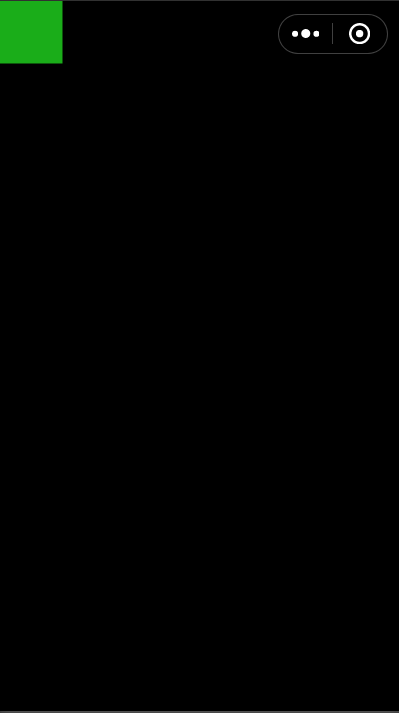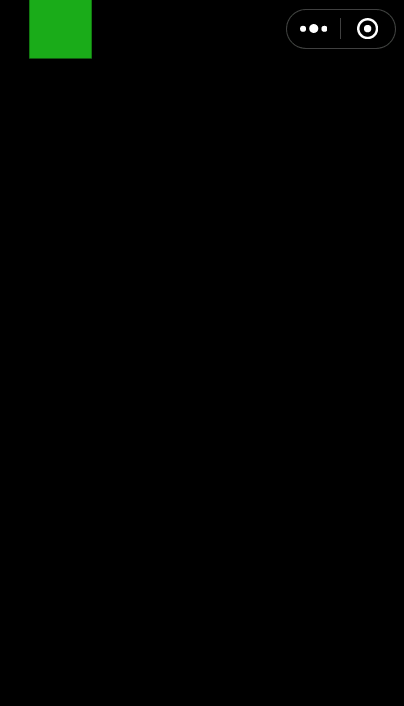首先新建一个微信小游戏项目。删掉项目初始化后的代码。建立一个game.js的文件:
const canvas = wx.createCanvas()
const context = canvas.getContext('2d')
context.fillStyle = '#1aad19'
context.fillRect(0, 0, 50, 50)效果如下:
接下来,让它动起来。
把下面的代码删掉
context.fillRect(0, 0, 50, 50)然后,定义屏幕宽高,及设置2个变量x和y:
const {
windowWidth,
windowHeight
} = wx.getSystemInfoSync()
let x=0
let y=0再定义一个绘制的方法
function draw(x, y) {
context.clearRect(0, 0, windowWidth, windowHeight)
context.fillRect(x, y, 50, 50)
}当执行draw(x,y)时,效果是一样的:
接下来,要让它动起来。简单一点,从左往右,出屏幕后再从左边重新开始。
const step=(timestamp)=>{
x+=1
if(x>=windowWidth){
x=0
}
draw(x,y)
window.requestAnimationFrame(step);
}
window.requestAnimationFrame(step);动是动起来了,但是这并不是引擎。所以,要用引擎的方式。
先建立一个codetyphon文件夹。里面新建一个sprite.js:
export default class Sprite {
constructor(x = 0, y = 0) {
this.x=x
this.y=y
}
draw(context){
context.fillStyle = '#1aad19'
context.fillRect(this.x, this.y, 50, 50)
}
}其中,constructor是初始化,定义了x和y默认为0.
draw方法调用context绘制了一个矩形。
接下来,在codetyphon中新建一个index.js文件:
import Sprite from './sprite'
export {
Sprite
}回到game.js,现在把sprite引入进来。
import {Sprite} from './codetyphon/index'然后,new出一个player对象:
const player = new Sprite()接着,把requestAnimationFrame改为:
const step = (timestamp) => {
context.clearRect(0, 0, windowWidth, windowHeight)
player.x += 1
if (player.x >= windowWidth) {
player.x = 0
}
player.draw(context)
window.requestAnimationFrame(step);
}
window.requestAnimationFrame(step);这时,之前let的x,y什么的都可以删掉了。
现在 game.js 代码如下:
import {
Sprite
} from './codetyphon/index'
const canvas = wx.createCanvas()
const context = canvas.getContext('2d')
const {
windowWidth,
windowHeight
} = wx.getSystemInfoSync()
const player = new Sprite()
const step = (timestamp) => {
context.clearRect(0, 0, windowWidth, windowHeight)
player.x += 1
if (player.x >= windowWidth) {
player.x = 0
}
player.draw(context)
window.requestAnimationFrame(step);
}
window.requestAnimationFrame(step);接下来继续改造,在sprite.js中增加一个update方法:
export default class Sprite {
constructor(x = 0, y = 0) {
this.x=x
this.y=y
}
update(){
}
draw(context){
context.fillStyle = '#1aad19'
context.fillRect(this.x, this.y, 50, 50)
}
}这里update是个空方法。
然后,建立一个player.js的文件:写一个Player类去继承Sprite类:
import Sprite from './codetyphon/sprite'
const {
windowWidth,
windowHeight
} = wx.getSystemInfoSync()
export default class Player extends Sprite {
constructor(x=0,y=0) {
super(x,y)
}
update(){
this.x+=1
if (this.x >= windowWidth) {
this.x = 0
}
}
}接下来,引入Player
import Player from './player'用Player去new一个player对象:
const player = new Player()相应地,requestAnimationFrame部分则变为:
const step = (timestamp) => {
context.clearRect(0, 0, windowWidth, windowHeight)
player.update()
player.draw(context)
window.requestAnimationFrame(step);
}
window.requestAnimationFrame(step);现在,整个game.js是这样的:
import Player from './player'
const canvas = wx.createCanvas()
const context = canvas.getContext('2d')
const {
windowWidth,
windowHeight
} = wx.getSystemInfoSync()
const player = new Player()
const step = (timestamp) => {
context.clearRect(0, 0, windowWidth, windowHeight)
player.update()
player.draw(context)
window.requestAnimationFrame(step);
}
window.requestAnimationFrame(step);虽然动的效果还是一样,但是代码已经不一样了。现在,一个引擎最基本的东西已经打造好了。

